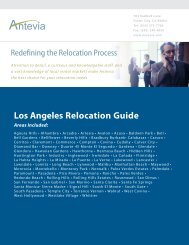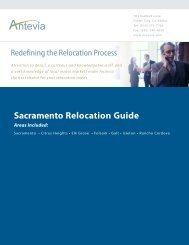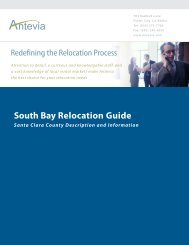San Francisco Relocation Guide - Antevia
San Francisco Relocation Guide - Antevia
San Francisco Relocation Guide - Antevia
You also want an ePaper? Increase the reach of your titles
YUMPU automatically turns print PDFs into web optimized ePapers that Google loves.
History<br />
The Tenderloin was born in the aftermath of the devastating 1906 Earthquake, when a<br />
large number of hotels were erected to accommodate the displaced victims of the disaster.<br />
By the 20s, the city's wealthier refugees had moved on, and the abandoned hotels were<br />
converted into low-income housing. The Tenderloin became notorious for its<br />
concentration of illegal bars, or "speakeasies" during Prohibition, and has since remained<br />
the core of <strong>San</strong> <strong>Francisco</strong>'s underworld.<br />
There are a number of stories about how the Tenderloin got its name. One is that it is a<br />
reference to an older neighborhood in New York with the same name and similar<br />
characteristics. Another is a reference to the neighborhood as the "soft underbelly"<br />
(analogous to the cut of meat) of the city, with allusions to vice, graft, and corruption.<br />
There are also some legends about the name, probably folklore, including that the<br />
neighborhood earned its name from the words of a local police captain, who was<br />
overheard saying that when he was assigned to another part of town, he could only afford<br />
to eat chuck steak on the salary he was earning, but after he was transferred to this<br />
neighborhood he was making so much money on the side soliciting bribes that now he<br />
could eat tenderloin instead. Another version of that story says that the officers that<br />
worked in the Tenderloin received a "hazard pay" bonus for working in such a violent<br />
area, and that is how they were able to afford the good cut of meat. Yet another story,<br />
also likely apocryphal, is that the name is a reference to the sexual parts of prostitutes<br />
(i.e., "loins").<br />
Prior to the emergence of the Castro as a major gay village, the Polk Gulch at the western<br />
side of the Tenderloin was one of the city's first gay neighborhoods. Few of the gay bars<br />
and clubs still exist on Polk Street. Parts of Polk Street now cater to the recent<br />
gentrification of the neighborhood - such bars as Vertigo, Hemlock, and Lush Lounge.<br />
However, many failed businesses in the area (such as a women's gym) attest to a<br />
continuing resistance to gentrification.<br />
Both the movie and book The Maltese Falcon were based in <strong>San</strong> <strong>Francisco</strong>'s Tenderloin.<br />
There is also an alley, in what is now Nob Hill, named for the book's author (Dashiell<br />
Hammett). It lies outside the Tenderloin because the boundary was defined differently<br />
than it is today. Some locations, such as Sam Spade's apartment and John's Grill, also no<br />
longer lie in the Tenderloin because local economics and real estate have changed the<br />
character and labeling of areas over time.<br />
Community<br />
The Tenderloin is an ethnically diverse community, consisting of middle class families,<br />
hip young people living in cheap apartments, and recent immigrants from Southeast Asia<br />
and Latin America. It is also home to a large population of homeless and those living in<br />
extreme poverty. The neighborhood is home to numerous non-profit social service







